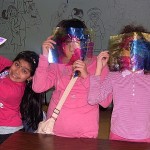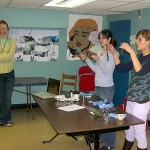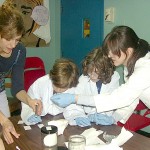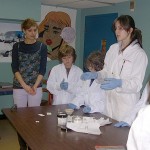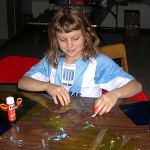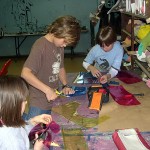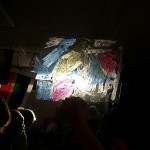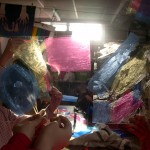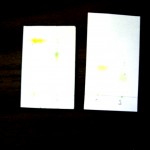Carotenoids
October 6, 2011 in Plants
On Friday, December 5th, 2008, the combined English and French fourth grade classes taught by Ms Reavell and Ms Breton at École F.A.C.E. School were exposed to the wonderful world of natural color as they were introduced to the carotenoids and vitamin A, thanks to university students Jess Aylsworth (BA Art Education, Concordia U), Tanya Godina (MSc., U. Montréal), Maya Grubisic (BA Art Education, Concordia U), and Zac Kenny (BA Art Education, Concordia U). First, we reviewed what we had learned about sulfur and bonding from the MLP last Friday. The students were quick to identify the presence of sulfur in foods and one student even described accurately hydrogen-bonding between two water molecules. Tanya and Maya led the class from talking about weak bonds that could be changed by heat to weak bonds that can be changed by light energy as we entered into a bilingual discussion of the carotenoids.
The students were quick to identify that the carotenoid, carotene was present in carrots which were a good source of vitamin A, which Tanya explained was produced from carotene in the body and is used by the eyes to see. Four student volunteers attired in proper lab-wear then performed chromatography on paper and glass plates coated with a thin layer of silica gel to see if the carotene in carrots could be identified in spinach. The students ground up the vegetables and with a little acetone, they extracted enough sample to spot slightly above the bottom of their paper and plates. The spotted paper and plates were then placed in chambers containing a solvent which eluted the color spots up the plate.
As discussed, the spinach too possessed a yellow color spot which moved up the plate faster than the green chlorophyl to the same distance as the yellow carotene spot from carrots. Hence, there seems to be carotene in spinach too. The students recognized that in Fall, leaves change colors as chlorophyll production slows to a halt and eventually all the chlorophyll is destroyed, unmasking the yellow, orange and red colors of the carotenoids. Noting the importance of the carotenoids in absorbing light to provide color and vision, the students made their own light catchers by employing different colored cellophane in a transparent collage. We thanked Team Caratenoid for their illuminating presentation.








